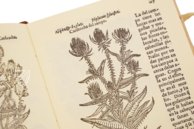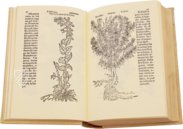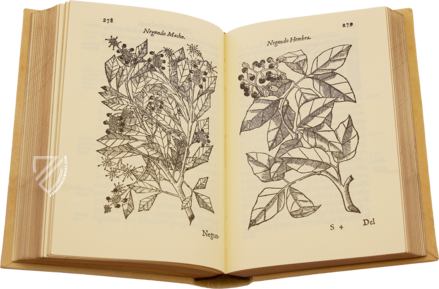Historia de Yervas, y Plantas, con los Nombres Griegos, Latinos y Españoles
(under 1,000€)
This Spanish translation of the famous De Historia stirpium, a cornerstone of botany, is presented together with 520 of the most beautiful botanical woodcuts ever created. The famous work by Leonhart Fuchs was one of the most popular and widely published scientific texts of the Renaissance and continued to be translated and reprinted until the end of the 16th century. Aside from accurately describing and depicting ca. 497 plants, more than 100 of them are described for the first time in the work. However, the religious conflicts of the 16th century hampered its publication, and this translation was censored by the Spanish Inquisition. Printed in the Spanish Netherlands, the codex represents a nexus of the scientific, technological, religious, political, and social developments of the 16th century, one of the most turbulent periods in European history.
Historia de Yervas, y Plantas, con los Nombres Griegos, Latinos y Españoles
De historia stirpium commentarii insignes or “Notable Commentaries on the History of Plants” is a Latin herbal, a botanical handbook primarily concerned with medicinal plants that is regarded as a masterpiece of the German Renaissance. First printed in Basel by Michael Isengrin in 1542, it was written by Leonhart Fuchs (1501–66) and is primarily based on the writings of the ancient Greek and Roman writers Dioscorides, Hippocrates, and Galen. Fuchs envisioned it as an image-forward work and as such it is adorned by 520 woodcuts, mostly depicting species of plants from the Old World with a few from the Americas, as well as portraits of some of those who were involved with the creation of the original work.
Juan de Jarava, a physician and botanist about whom little is known, served as the translator of the work and offers a brief caption in Spanish for each illustration. This edition was printed in Amsterdam by Jean de Laet (1525–67) in 1557, one year after the Netherlands passed to the Spanish branch of the House of Habsburg under the personal rule of King Philip II (1527–98) after the abdication of his father, Holy Roman Emperor Charles V (1500–58). Since the work fell within the Spanish sphere of influence, it was also subject to the censorship of the Spanish Inquisition.
A Team Effort
Fuchs spent at least a decade gathering information as well as specimens for his home’s botanical garden in preparation for the publication of this book. He soon had one of the largest “botanical libraries” in Europe, which allowed the artists who contributed to the work to make original drawings from living specimens. Albrecht Meyer was the primary artist responsible for these accurate and realistic botanical drawings and is depicted sketching a plant in the codex. These sketches were converted into woodcuts by the draftsman and painter Heinrich Füllmaurer (ca. 1497–1547/48). Also known as Vitus, Veit Rudolf Speckle (d. 1550) was a printmaker in Strasbourg who actually cut the blocks and printed the woodcuts. They are the most beautiful and exact botanical woodcuts of 16th century Europe make the work one of the most beautifully illustrated books on the subject.
Censorsed by the Spanish Inquisition
Leonhart Fuchs was a Bavarian who adopted Lutheranism while studying in Erfurt ca. 1520. Like many Protestant authors, Fuchs’ works were banned or heavily censored by the Spanish Inquisition. However, even these zealots recognized the indispensable nature of the medical knowledge that the work contained and thus allowed it to be published, but only without giving credit to either Fuchs, Dioscorides, or the translator of the work, Juan de Jarava. This can be confirmed by consulting the specimen housed in the Biblioteca Histórico-Médica de la Universitat de València, which consists of a vernacular translation used by the censors of the Spanish Inquisition to create the official version. However, their efforts were in vain because the Latin work was also translated into German, Dutch, and French, printed in 39 editions during the author’s lifetime, and an English translation appeared twenty years after his death. The light of knowledge could simply not be obscured, even by powerful and fanatical inquisitors.
Codicology
- Alternative Titles
- Geschichte der Pflanzen mit griechischen und lateinischen Namen
- Size / Format
- 550 pages / 17.0 × 11.0 cm
- Origin
- Belgium
- Date
- February 28, 1557
- Epochs
- Style
- Illustrations
- 520 woodcuts of plants
- Content
- Encyclopedia of mainly European plants, but also some American plants
- Artist / School
- Leonhart Fuchs (author)
Juan de Jarava (translator)
Jean de Laet (printer)
Historia de Yervas, y Plantas, con los Nombres Griegos, Latinos y Españoles
Acanthus
Acanthus is useful as an efficacious plant for treating illnesses including asthma, diabetes, leprosy, hepatitis, snake bites, and rheumatoid arthritis. Aside from its medicinal uses, acanthus leaves feature prominently in Christian art, whereby this perennial plant is a symbol of enduring life. Its thorny leaves also represent pain, sin, and punishment. The generic name “acanthus” is derived from the Greek term ἄκανθος and it is a common decorative motif in Corinthian capitals from ancient Greece.

Historia de Yervas, y Plantas, con los Nombres Griegos, Latinos y Españoles
Asparagus
This perennial flowering plant is both cultivated as a spring vegetable as well as growing wild. Its young shoots are a popular foodstuff around the world, but perhaps nowhere more so than in Germany where 57,000 tons of white asparagus is grown every year. The white color is cultivated by covering the shoots to protect them from sunlight and thus photosynthesis, which turns them green.
Although the shoots are edible, the small red berries produced by its bell-shaped, greenish white to yellowish flowers are toxic to humans. This engraving depicts a mature asparagus plant as it would appear in late summer with its feathery foliage hanging in the heat and also includes the root system of the asparagus plant, often referred to as a “crown”.

#1 Historia de Yervas, y Plantas, con los Nombres Griegos, Latinos y Españoles
Language: Spanish
(under 1,000€)
- Treatises / Secular Books
- Apocalypses / Beatus
- Astronomy / Astrology
- Bestiaries
- Bibles / Gospels
- Chronicles / History / Law
- Geography / Maps
- Saints' Lives
- Islam / Oriental
- Judaism / Hebrew
- Single Leaf Collections
- Leonardo da Vinci
- Literature / Poetry
- Liturgical Manuscripts
- Medicine / Botany / Alchemy
- Music
- Mythology / Prophecies
- Psalters
- Other Religious Books
- Games / Hunting
- Private Devotion Books
- Other Genres
- Afghanistan
- Armenia
- Austria
- Belgium
- Belize
- China
- Colombia
- Costa Rica
- Croatia
- Cyprus
- Czech Republic
- Denmark
- Egypt
- El Salvador
- Ethiopia
- France
- Germany
- Greece
- Guatemala
- Honduras
- Hungary
- India
- Iran
- Iraq
- Israel
- Italy
- Japan
- Jordan
- Kazakhstan
- Kyrgyzstan
- Lebanon
- Liechtenstein
- Luxembourg
- Mexico
- Morocco
- Netherlands
- Palestine
- Panama
- Peru
- Poland
- Portugal
- Russia
- Serbia
- Spain
- Sri Lanka
- Sweden
- Switzerland
- Syria
- Tajikistan
- Turkey
- Turkmenistan
- Ukraine
- United Kingdom
- United States
- Uzbekistan
- Vatican City
- A. Oosthoek, van Holkema & Warendorf
- Aboca Museum
- Ajuntament de Valencia
- Akademie Verlag
- Akademische Druck- u. Verlagsanstalt (ADEVA)
- Aldo Ausilio Editore - Bottega d’Erasmo
- Alecto Historical Editions
- Alkuin Verlag
- Almqvist & Wiksell
- Amilcare Pizzi
- Andreas & Andreas Verlagsbuchhandlung
- Archa 90
- Archiv Verlag
- Archivi Edizioni
- Arnold Verlag
- ARS
- Ars Magna
- ArtCodex
- AyN Ediciones
- Azimuth Editions
- Badenia Verlag
- Bärenreiter-Verlag
- Belser Verlag
- Belser Verlag / WK Wertkontor
- Benziger Verlag
- Bernardinum Wydawnictwo
- BiblioGemma
- Biblioteca Apostolica Vaticana (Vaticanstadt, Vaticanstadt)
- Bibliotheca Palatina Faksimile Verlag
- Bibliotheca Rara
- Boydell & Brewer
- Bramante Edizioni
- Bredius Genootschap
- Brepols Publishers
- British Library
- C. Weckesser
- Caixa Catalunya
- Canesi
- CAPSA, Ars Scriptoria
- Caratzas Brothers, Publishers
- Carus Verlag
- Casamassima Libri
- Chavane Verlag
- Christian Brandstätter Verlag
- Circulo Cientifico
- Club Bibliófilo Versol
- Club du Livre
- CM Editores
- Collegium Graphicum
- Collezione Apocrifa Da Vinci
- Comissão Nacional para as Comemorações dos Descobrimentos Portugueses
- Coron Verlag
- Corvina
- CTHS
- D. S. Brewer
- Damon
- De Agostini/UTET
- De Nederlandsche Boekhandel
- De Schutter
- Deuschle & Stemmle
- Deutscher Verlag für Kunstwissenschaft
- DIAMM
- Droz
- E. Schreiber Graphische Kunstanstalten
- Ediciones Boreal
- Ediciones Grial
- Ediclube
- Edições Inapa
- Edilan
- Editalia
- Edition Deuschle
- Edition Georg Popp
- Edition Leipzig
- Edition Libri Illustri
- Editiones Reales Sitios S. L.
- Éditions de l'Oiseau Lyre
- Editions Medicina Rara
- Editorial Casariego
- Editorial Mintzoa
- Editrice Antenore
- Editrice Velar
- Edizioni Edison
- Egeria, S.L.
- Eikon Editores
- Electa
- Emery Walker Limited
- Enciclopèdia Catalana
- Eos-Verlag
- Ephesus Publishing
- Ernst Battenberg
- Eugrammia Press
- Extraordinary Editions
- Fackelverlag
- Facsimila Art & Edition
- Facsimile Editions Ltd.
- Facsimilia Art & Edition Ebert KG
- Faksimile Verlag
- Feuermann Verlag
- Folger Shakespeare Library
- Franco Cosimo Panini Editore
- Friedrich Wittig Verlag
- Fundación Hullera Vasco-Leonesa
- G. Braziller
- Gabriele Mazzotta Editore
- Gebr. Mann Verlag
- Gesellschaft für graphische Industrie
- Getty Research Institute
- Giovanni Domenico de Rossi
- Giunti Editore
- Graffiti
- Grafica European Center of Fine Arts
- Guido Pressler
- Guillermo Blazquez
- Gustav Kiepenheuer
- H. N. Abrams
- Harrassowitz
- Harvard University Press
- Helikon
- Hendrickson Publishers
- Henning Oppermann
- Herder Verlag
- Hes & De Graaf Publishers
- Hoepli
- Holbein-Verlag
- Houghton Library
- Hugo Schmidt Verlag
- Idion Verlag
- Il Bulino, edizioni d'arte
- ILte
- Imago
- Insel Verlag
- Instituto Nacional de Antropología e Historia
- Istituto dell'Enciclopedia Italiana - Treccani
- Istituto Ellenico di Studi Bizantini e Postbizantini
- Istituto Geografico De Agostini
- Istituto Poligrafico e Zecca dello Stato
- Italarte Art Establishments
- J. Thorbecke
- Jan Thorbecke Verlag
- Johnson Reprint Corporation
- Josef Stocker
- Josef Stocker-Schmid
- Jugoslavija
- Karl W. Hiersemann
- Kasper Straube
- Kaydeda Ediciones
- Kindler Verlag / Coron Verlag
- Kodansha International Ltd.
- Konrad Kölbl Verlag
- Kurt Wolff Verlag
- La Liberia dello Stato
- La Linea Editrice
- La Meta Editore
- Lambert Schneider
- Landeskreditbank Baden-Württemberg
- Leo S. Olschki
- Les Incunables
- Library of Congress
- Libreria Musicale Italiana
- Lichtdruck
- Lito Immagine Editore
- Lumen Artis
- Lund Humphries
- M. Moleiro Editor
- Maison des Sciences de l'homme et de la société de Poitiers
- Manuscriptum
- Martinus Nijhoff
- Maruzen-Yushodo Co. Ltd.
- MASA
- McGraw-Hill
- Metropolitan Museum of Art
- Militos
- Millennium Liber
- Müller & Schindler
- Nahar and Steimatzky
- National Library of Wales
- Neri Pozza
- Nova Charta
- Oceanum Verlag
- Odeon
- Orbis Mediaevalis
- Orbis Pictus
- Österreichische Staatsdruckerei
- Oxford University Press
- Pageant Books
- Parzellers Buchverlag
- Patrimonio Ediciones
- Pattloch Verlag
- PIAF
- Pieper Verlag
- Plon-Nourrit et cie
- Prestel Verlag
- Princeton University Press
- Prisma Verlag
- Priuli & Verlucca, editori
- Pro Sport Verlag
- Propyläen Verlag
- Pytheas Books
- Quaternio Verlag Luzern
- Reales Sitios
- Recht-Verlag
- Reichert Verlag
- Reichsdruckerei
- Riehn & Reusch
- Roberto Vattori Editore
- Rosenkilde and Bagger
- Roxburghe Club
- Salerno Editrice
- Sarajevo Svjetlost
- Schöck ArtPrint Kft.
- Schulsinger Brothers
- Scolar Press
- Scrinium
- Scripta Maneant
- Scriptorium
- Shazar
- Siloé, arte y bibliofilia
- SISMEL - Edizioni del Galluzzo
- Sociedad Mexicana de Antropología
- Société des Bibliophiles & Iconophiles de Belgique
- Soncin Publishing
- Sorli Ediciones
- Stainer and Bell
- Studer
- Styria Verlag
- Sumptibus Pragopress
- Szegedi Tudomànyegyetem
- Taberna Libraria
- Tarshish Books
- Taschen
- Tempus Libri
- Testimonio Compañía Editorial
- Thames and Hudson
- The Clear Vue Publishing Partnership Limited
- The Facsimile Codex
- The Folio Society
- The Marquess of Normanby
- The Richard III and Yorkist History Trust
- Tip.Le.Co
- TouchArt
- TREC Publishing House
- TRI Publishing Co.
- Trident Editore
- Typis Regiae Officinae Polygraphicae
- Union Verlag Berlin
- Universidad de Granada
- University of California Press
- University of Chicago Press
- Urs Graf
- Vallecchi
- Van Wijnen
- VCH, Acta Humaniora
- VDI Verlag
- VEB Deutscher Verlag für Musik
- Verlag Anton Pustet / Andreas Verlag
- Verlag Bibliophile Drucke Josef Stocker
- Verlag der Münchner Drucke
- Verlag für Regionalgeschichte
- Verlag Styria
- Vicent Garcia Editores
- W. Turnowski Ltd.
- W. Turnowsky
- Waanders Printers
- Wiener Mechitharisten-Congregation (Wien, Österreich)
- Wissenschaftliche Buchgesellschaft
- Wissenschaftliche Verlagsgesellschaft
- Wydawnictwo Dolnoslaskie
- Xuntanza Editorial
- Zakład Narodowy
- Zollikofer AG



























































